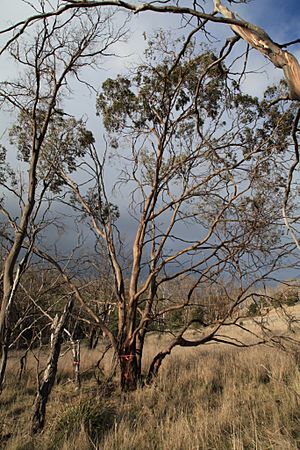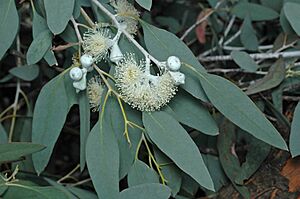Morrisby's gum facts for kids
Quick facts for kids Morrisby's gum |
|
|---|---|
 |
|
| Eucalyptus morrisbyi in Calverts Hill Nature Reserve, near Sandford | |
| Conservation status | |
| Scientific classification | |
| Genus: |
Eucalyptus
|
| Species: |
morrisbyi
|
Morrisby's gum (Eucalyptus morrisbyi) is a special tree that grows only in a small area of Tasmania, Australia. It's a small to medium-sized tree. You can spot it by its bark, which is rough and loose near the bottom of its trunk, but smooth and pale grey higher up. Its leaves are shaped like spears or eggs. When it flowers, it has groups of three white buds that open into white flowers. Later, it grows fruit that look like small barrels or cylinders.
This tree is quite rare in the wild, found in only a few small groups. However, many people have planted it in their gardens because it's a beautiful ornamental tree.
Contents
What Does Morrisby's Gum Look Like?
Morrisby's gum usually grows to be about 6–16 m (20–52 ft) (20-52 feet) tall. It has a special woody lump at its base called a lignotuber. This helps the tree regrow if it gets damaged, like after a bushfire.
Its bark is smooth and pale grey or brown. But near the bottom of the trunk, you'll often see loose, rough pieces of bark.
Leaves and Flowers
Young Morrisby's gum plants have round leaves that are dull bluish-green. These leaves are about 10–45 mm (0.39–1.77 in) (0.4-1.8 inches) long and 15–40 mm (0.59–1.57 in) (0.6-1.6 inches) wide. They grow in pairs right opposite each other on the stem and often have wavy edges.
As the tree gets older, its adult leaves change. They become more like spear or egg shapes, or sometimes oval. They are dull bluish-green on both sides, about 47–100 mm (1.9–3.9 in) (1.9-3.9 inches) long and 15–40 mm (0.59–1.57 in) (0.6-1.6 inches) wide. Each leaf has a stalk called a petiole, which is about 9–25 mm (0.35–0.98 in) (0.4-1 inch) long.
The flower buds grow in groups of three where the leaves meet the stem (called axils). Each group of buds sits on a small stalk called a peduncle, which is about 4–10 mm (0.16–0.39 in) (0.16-0.4 inches) long. The buds themselves are pear-shaped or oval, about 7–8 mm (0.28–0.31 in) (0.28-0.31 inches) long and 5–6 mm (0.20–0.24 in) (0.2-0.24 inches) wide. They have a pointy cap called an operculum.
Morrisby's gum can flower almost any time of the year, but it flowers most from January to April. Its flowers are white.
Fruit
After flowering, the tree produces woody fruit. These fruits are shaped like barrels or cylinders and are about 6–9 mm (0.24–0.35 in) (0.24-0.35 inches) long and 7–8 mm (0.28–0.31 in) (0.28-0.31 inches) wide. They are a type of capsule, which means they open to release seeds.
Who Named Morrisby's Gum?
The scientific name Eucalyptus morrisbyi was first officially described in 1939 by a person named Robert Brett. He wrote about it in a scientific paper.
Brett named the tree after "J. R. Morrisby." John Robert Morrisby (1832–1923) was a person who collected seeds of this tree. He then planted many of them on his farm near Sandford. Even many years later, in 1978, a Morrisby family still lived on that farm!
Where Does Morrisby's Gum Live?
Morrisby's gum likes to grow in dry woodlands. You'll often find it in gullies, which are small valleys between hills. It usually grows in groups where it's the main type of tree.
In the wild, Morrisby's gum is only found in the Cremorne area of Tasmania. There are just two main groups of these trees on the eastern side of the River Derwent.
Why Is Morrisby's Gum Endangered?
Even though many Morrisby's gum trees have been planted in gardens, the wild populations are still shrinking. This is why the Australian government has listed it as "endangered" under the Environment Protection and Biodiversity Conservation Act 1999. The Tasmanian government also lists it as endangered.
Scientists believe there are fewer than 2,500 mature Morrisby's gum trees left in the wild, spread across no more than five locations.
Threats to Morrisby's Gum
Several things are making it hard for Morrisby's gum to survive in the wild:
- Land Clearing: Areas where the trees grow are being cleared for other uses.
- Climate Change: Changes in weather patterns can make it harder for the trees to thrive.
- Animal Browsing: Animals like possums eat the young trees and leaves.
- Insect Damage: Insects, especially the autumn gum moth (Mnesampela privata), can harm the trees.
- Competition: Other plants, like the native vine Cassytha pubescens and introduced weeds such as serrated tussock (Nassella trichotoma), compete with Morrisby's gum for resources.
- Fire: The wrong kind of bushfires can also damage or destroy the wild populations.



